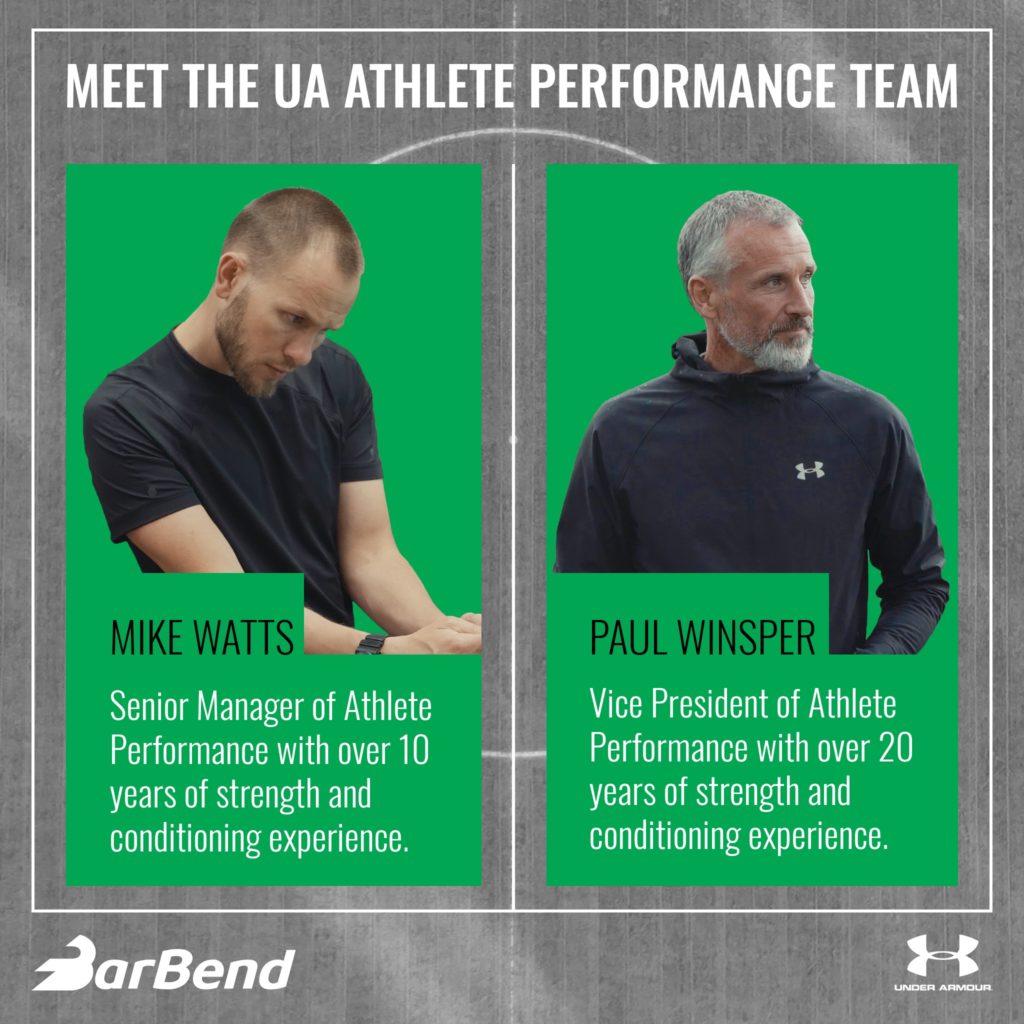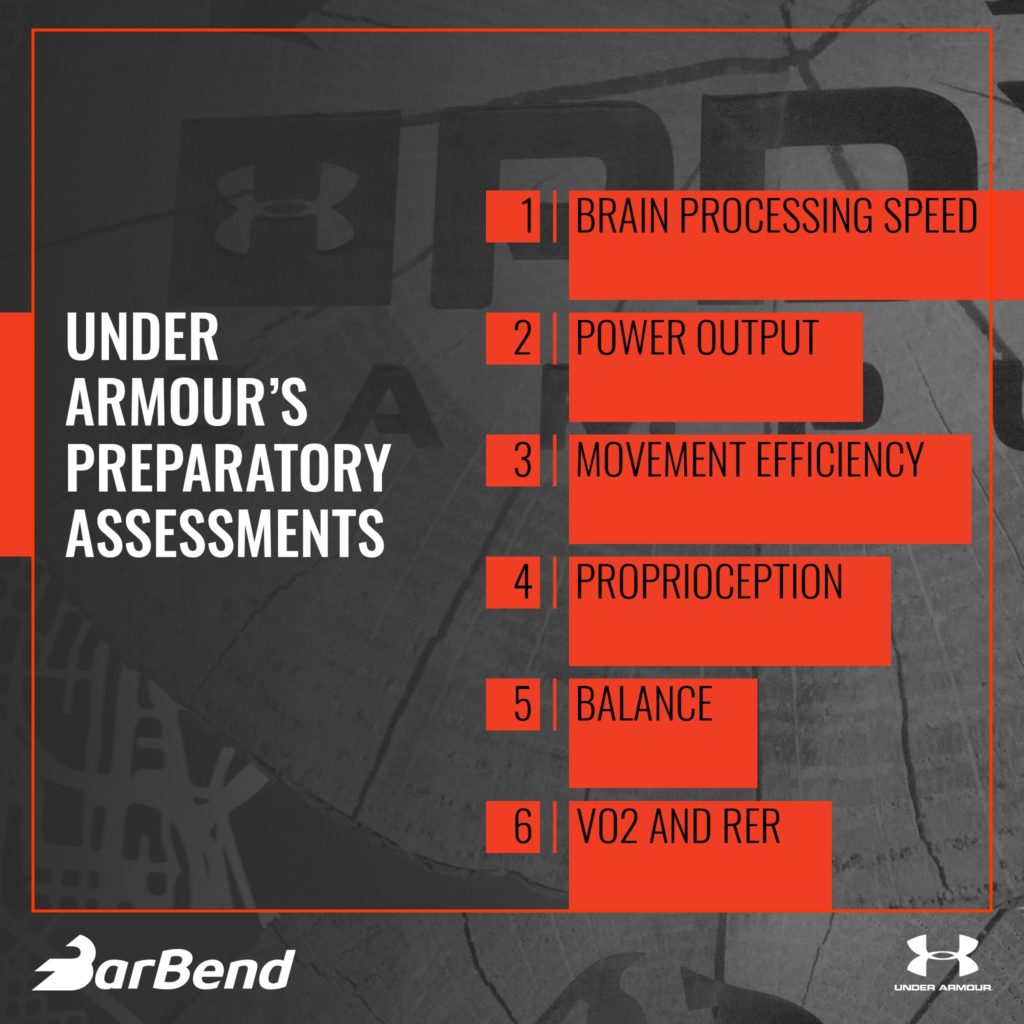I was about 27 miles into the ride when I realized I “bonked” – a term that I had never heard before – but quickly began to understand. James Newbury and the whole Under Armour Athlete Performance Team were miles ahead of me, both literally and figuratively.
Biking up the final hill before grabbing an Almond Latte, a James Newbury favorite, I thought I was going to collapse into a big pool of a defeated man on the pavement. What started as an adventure with one of the world’s fittest athletes and the Under Armour Athlete Performance Team quickly turned into an internal battle of grit and discovery of personal limits.
[Read Chapter 2: How Under Armour Helps James Newbury Train and Recover!]
How Under Armour Approach’s Every Athlete
When it comes to training, coaches and athletes are like artists and paintings. Athletes and coaches are constantly reworking their systems and implementing different tools to create the masterpiece that manifests as the athlete’s performance. Over the course of their career, an athlete’s performance is their continual display of artwork.
The Under Armour Human Performance Team, based out of Portland, Oregon, is made up of artists. They take world record holders, Olympians, and athletes at the absolute peak of their careers from a variety of sports and provide them with prep, performance, and recovery tools to help them paint their bigger pictures. Every elite athlete has their own systems in place to prepare for battle, and Under Armour understands this and equips them with the best means possible to continue to excel.

In Newbury’s case, success in fitness is the culmination of multiple disciplines. Newbury says that his training is similar to casting a wide net, he wants to capture as many areas of specialty as he can. It’s one thing to hear about how an elite athlete trains, but it’s another to physically see it and partake in it.
Contrary to simply providing athletes with equipment, the Under Armour Human Performance Team gives their athletes something much more intangible. We were lucky enough to cover Newbury and the Under Armour Athlete Performance Team for three days as Newbury preps for the Games taking place in early August – this is their story.
Chapter 1: Prep and Assessment
When arriving at the Under Armour campus in Portland, myself, BarBend’s videographer, Jordan, and our Creative Director, Josh, really had no idea what to expect. I had met the main coaches from the Athlete Performance Team before at an Under Armour RUSH event, Mike Watts and Paul Winsper, however, I had never seen them in action with a top-level athlete like James Newbury.
Newbury, a 3-time CrossFit Games competitor, came to Portland to work with the Under Armour team for the second time. The first time Newbury and the team worked together was in Baltimore a few months ago. During their first meeting, the UA team assessed Newbury’s overall readiness and training state with multiple assessments.
Under Armour’s team firmly believes that diverse athletic assessments are critical for ensuring progress and longevity in an athlete’s respective sport.
After all, the athletes Under Armour works with are at the top of their game, so it’s not always about pushing and finding new limits, but preserving the current levels of performance and improving current systems.
Mike Watts, Senior Manager of the Under Armour Athlete Performance team explained, “The assessments we perform are where science meets art. The combination of how an athlete feels and the objective data we record allow us to approach training and adaptations through the most thoughtful means possible.”

Standing in the Athlete’s Lounge with Newbury and the UA Team, they began to plot out a week’s worth of training on the whiteboard. Newbury sculpted the week’s training activities, while the UA team filled in the gaps of providing Newbury with equipment, the best places to train, and the proper training tools.
After filling the 15-foot whiteboard, Newbury headed into the gym to flow through the assessments that the UA Team had setup. It’s important to note that the last time Newbury worked with the UA team, they performed the same tests. The UA Team explained that every time an athlete steps into the gym with them, they’re a completely different person.
The list of assessments Under Armour performs are like road maps.
Results from these tests help fill the time periods and gaps where the Athletic Performance Team are not with the athlete. In Newbury’s case, his data is incredibly useful to help the team understand his current training state, imbalances that may have developed over the last few months, and areas where he might be lagging.
To say that Under Armour Performance Team’s assessments are dense would be an understatement. As opposed to your routine personal training assessment at the local globo gym, the UA team tests virtually everything from brain processing speed to VO2.
How Newbury moves is his livelihood, so UA tries to help him recognize potential pitfalls in his movement mechanics, performance readiness, and all around well-being.
Neural and Body Composition Testing
The first assessments the UA team perform laid the groundwork for Newbury’s current training readiness and body composition. To gauge these two, the UA Team assessed Newbury’s heart rate variability (HRV) and body fat.
The first assessment, HRV, is critical for understanding an athlete’s autonomic nervous system’s health. HRV is the slight variability between heart beats that suggests balance between the sympathetic and parasympathetic nervous systems. UA’s team is very keen on understanding HRV because it can suggest if more recovery work is needed and how much they can functionally overreach.
Newbury’s HRV read as normal (relative to his norm) and his body fat was comfortably below 10%, which is exactly where he predicted it to be before getting tested. The next assessments shifted to analyzing Newbury’s brain processing speed.
In Under Armour’s gym, there’s a significant portion of the left wall that’s covered in three rows of flat LED lights. For this assessment, Newbury stood about 6-feet from the wall and watched the middle row as five lights quickly lit up with a specific design before going black. Newbury then had to touch the light that served as the outlier. If he got the light correct, the lights sped up. If he got it wrong, the lights would go back to their previous speed.
This test is not performed to assess reaction speed, but to analyze how fast Newbury’s brain can process information and retain it.
Brain processing speed can relate to nervous system health, Watts explained. Watts told me if coaches can tie HRV with brain processing speed, then they can build a bigger picture understanding of an athlete’s overall physical and mental health.
Jump, Movement Efficiency, and Range of Motion Testing
After completing the neural, body composition, and brain processing tests, the UA Team began diving into Newbury’s movement efficiency.
They wanted to assess Newbury’s jumping abilities and reaction speed. Newbury stood in an octagon that used LED lights to assess his vertical jump, single-leg jump, and counter jump speeds. These tests are useful to analyze Newbury’s power output, any potential imbalances between his legs, and lower-body reaction speed.
After performing about 15-minutes of various jump tests, the UA Team had Newbury perform a variety of movement efficiency tests.
The UA team firmly believes that conquering the basics of movement is paramount for higher performance and longevity.
Newbury began the movement assessment by performing a battery of tests provided by the app Fusionetics, an app that focuses on movement mechanics at various joints. Following these tests, Watts had Newbury lie on a massage table and then put his joints through various range of motion tests sans gravity.
Watts explained, “It’s important for us to understand how the body is moving under one’s own power and without gravity. This can help paint the bigger picture of how joints are functioning, moving, and performing.”
The UA team said that these tests are staples for athletes every time they visit. If an athlete tests poorly in any area, then the team provides them with tools to create a balance in the trouble area.
These tests help UA’s Team and Newbury ask questions like,
- Is one side of the body functioning better than the other?
- Is there an imbalance at one of the joints?
- Where are movement limitations?
Sensory Input and Power Testing
Sensory input and power are both essential to have for a competitive athlete at Newbury’s level. To test Newbury’s sensory abilities, the UA team had him wear a pair of sensory deprivation glasses. At first, the glasses limited eyesight slightly, however, it wasn’t long until the glasses were only allowing Newbury only 20% of his overall vision.
While wearing these glasses, Watts and Winsper had Newbury catch a foam ball that was tossed and bounced towards him. This test may not initially seem like it has a high carryover to competitive fitness, but its application is far more important that what’s seen on the surface. Watts explained further saying,
“Imagine Newbury has an event with something like a rope climb and handstand walk that are back-to-back. His sensory abilities will play a role in both his depth perception of the handstand walk and the tracking of the rope in the climb.”
To test power, the UA team equipped Newbury with a medicine ball and instructed to throw it at the wall with maximal force, once off his right foot and the other off his left, and a third with both feel parallel to the wall.
Winsper described the importance of this test saying, “An athlete needs to have relative balance between each side when producing power. By assessing both sides, we get the larger picture of Newbury’s body, as opposed to only testing a straight on medicine ball through.”
To no surprise, Newbury performed well-over the norm for both his right and left side, and the group headed to the stationary bike for the final test.
A test that Newbury was both looking forward to and dreading…
VO2 and RER Test
Newbury is a well-balanced athlete, but if there’s one area he admittedly knows he performs better in it’s cardio-based workouts.
His final test from the long morning of assessments included an all-out 20-min bike ride with a face mask. The main goal for this test is to assess Newbury’s VO2, respiratory exchange ratio (RER), and respiratory quotient (RQ). All of these readings suggest three very critical components to Newbury’s success in competition,
- VO2 is the maximum amount of oxygen Newbury’s body can uptake during maximal exercise.
- RER explains how much carbon dioxide Newbury’s body is producing in relation to the room’s air.
- Newbury’s RQ suggests what type of fuel he’s burning during intense exercise (Is it predominantly fat or carbs?).
After the grueling 20-minute bike ride, drenched in sweat, Newbury got off the bike and looked around the room gasping for air saying,
“I’m in the hurt locker, boys.”
Now that you’ve prepped yourself for competition, it’s time to train and recover!